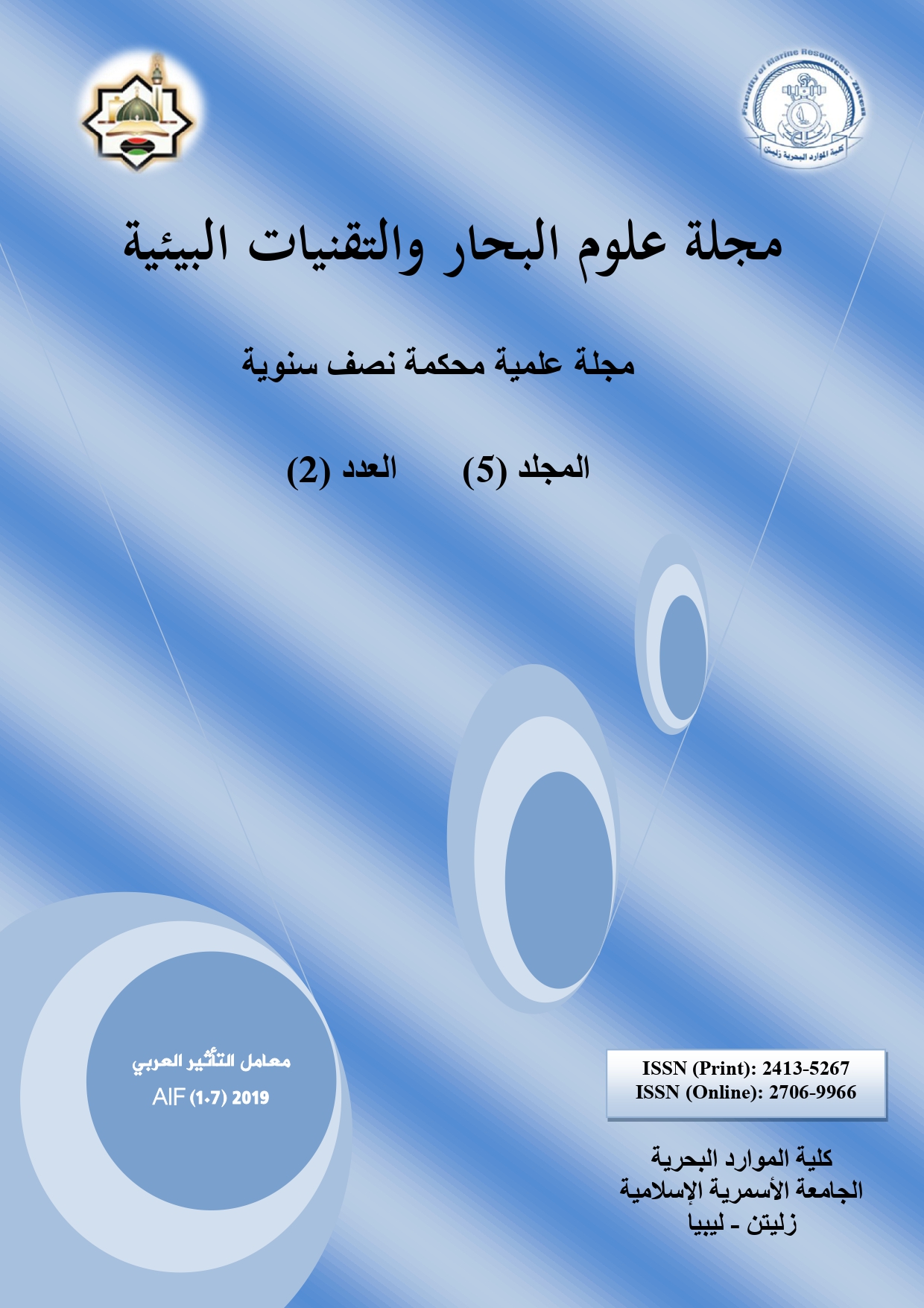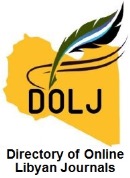طرق معملية وإحصائية لتقدير تعرية التربة على منحدرات الجبل الأخضر
DOI:
https://doi.org/10.59743/jmset.v5i2.54الكلمات المفتاحية:
الجبل الأخضر، تعرية التربة، خصائص التربة، ليبياالملخص
قامت الدراسة بتطبيق بعض الطرق المعملية الديناميكية لقياس وتقدير قابلية التربة للتعرية المائية، كما تم تطبيق اختبارات أخرى مثل الطرق المعملية غير الديناميكية والطرق الإحصائية. تمت الاختبارات على عينات تربة سطحية بعمق (0–10سم) تم جمعها من خمسة مواقع تقع على المنحدرات الجنوبية شبه الجافة بالجبل الأخضر وهي (المصيليبة، مراوة، قندولة القريعات، قندولة سيرة عليا، قصر المستاشي). النتائج أظهرت انسجاما وتوافقا بين نتائج كل الطرق الديناميكية والتي بينت أن ترب منطقة قصر المستاشي هي الأكثر قابلية للانجراف وهو ما يتوافق مع تدهور خصائصها الفيزيائية والهيدروليكية وانخفاض محتواها من المادة العضوية، كما تبين ان ترب منطقة سيرة عليا كانت الأقل انجرافيه وهو ما يتوافق مع ارتفاع محتواها من الطين والمادة العضوية وتجمعات التربة الثابتة مائيا. من ناحية أخرى لم تنجح الطريقة الإحصائية باستخدام الشكل البياني لويشماير (K-USLE) في اعطاء نتائج تتفق مع الطرق المعملية الديناميكية حيث أظهرت نتائجه ان ترب القريعات هي الأكثر نسبيا في القابلية للانجراف رغم أن هذه الترب ذات محتوى جيد من الطين والمادة العضوية وتجمعات التربة الثابتة مائيا. ويرجع السبب في التقدير العالي للطريقة الاحصائية لارتفاع محتوى ترب القريعات من مفصول السلت، وعليه يلاحظ التذبذب في نتائج الطرق الاحصائية بسبب التغيرات الطفيفة في مستويات أحد مكونات عينة التربة تحت الدراسة، وهو ما يضع شكوكا حول كفاءة الطرق الإحصائية في اعطاء توصيف موثوق لقابلية التربة للتعرية المائية، بينما كانت الطرق المعملية الديناميكية هي الأقرب لخصائص التربة وظروفها الحقلية مما قد يجعلها مرجعا أكثر واقعية ويمكن الاعتماد عليها كطرق قليلة الكلفة وسهلة التطبيق تساهم في قياس الانجرافيه بكفاءة أكبر وتوصيف مخاطر التعرية المائية بمنطقة الجبل الأخضر.
التنزيلات
المراجع
Abu Hammad A.H., Lundervam H., and Berresen T. (2005). Adaptation of RUSLE in the Eastern part of the Mediterranean Region. Environmental Management, 34(6): 829-841.
Aburas M.M. (1997). The effects of vegetation removal for agricultural purposes on soil loss and properties, Al-Jabal Alkhdar, Libya. M.Sc. thesis, Omar Al-Mukhtar University, Libya (In Arabic)
Aburas M. (2009). Assessment of Soil Erodibility in Relation to Soil Degradation and Land Use in `Mediterranean Libya. PhD thesis, University of Newcastle upon Tyne, UK.
Adams J.E., Kirkham D., and Scholtes W.H. (1958). Soil erodibility and other physical properties of some Iowa soils. Iowa State College Journal of Science, 32(4): 485-540.
Barthès B., and Roose E. (2002). Aggregate stability as an indicator of soil susceptibility to runoff and erosion; validation at several levels. CATENA, 47(2): 133-149.
Barthes B., Azontonde A., Boli B.Z., Part C., and Roose E. (2000). Field-scale run-off and erosion in relation to topsoil aggregate stability in three tropical regions (Benin, Cameroon, Mexico). European Journal of Soil Science, 51: 485-496.
Cerda A. (2000). Aggregate stability against water forces under different climates on agriculture land and scrubland in southern Bolivia. Soil and Tillage Research, 57(3): 159-166.
Combeau A., and Monnier G. (1961). Methods d,etude de la stabilite structural. Application aux sols tropicaux.
Diaz-Fierros F., and Benito E. (1996). Rainwash erodibility of Spanish soils. in Rubio, J. L. C., A(ed), Soil degradation and desertification in Mediterranean environments. Logrono, Spain: Geoforma Ediciones, pp. 91-105.
Ekwue E.I. (1984). Experimental investigation on the effect of preparation of soil samples on measured values of soil erodibility. M.Sc. Thesis, Cranfield Institute of Technology, Silso College, UK.
FAO (1969). Report to the government of Libya on development on tribal lands settlement project. FAO, Rome (SF 20).
Gebril M.A. (1995). Water erosion on the northern of Al-Jabal Alkhdar of Libya. PhD thesis, Durham University, UK.
GEFLI. (1975). Study of soil and water conservation in Jabal Lakhdar, Libya. Final report.
Goldsmith P.F. (1977). A practical guide to the use of the universal soil loss equation. Published BAI Tech. Monogr, pp: 34.
Hussein M.H., Kariem T.H., and Othman K. (2007). Predicting soil erodibility in northern Iraq using natural runoff plot data. Soil and Tillage Research, 94(1): 220-228.
Kemper W.D., Trout T.J., Brown M.J., and Rosenau R.C. (1985). Furrow erosion and water and soil management. Transactions of the ASAE, 28(5): 1564-1572.
Kuhn N.J., and Bryan R.B. (2004). Drying, soil surface condition and interrill erosion on two Ontarion soils. Catena, 57(2): 113-133.
Lal R. (2001). Soil degradation by erosion. Land degradation & Development, 12(6): 519-539.
Lama M. (1996). Desertification in Benghazi plain, geographic study in causes and characteristics. PhD thesis, Faculty of Arts, University of Cairo, Egypt. (In Arabic)
Le Bissonnais Y. (1996). Aggregate stability and assessment of soil crustability and erodibility: I. Theory and methodology. European Journal of Soil Science, 47(4): 425-437.
Le Bissonnais Y., and Arrouays D. (1997). Aggregate stability and assessment of soil crustability and erodibility: II. Application to humic loamy soils with various organic carbon contents. European Journal of Soil Science, 48: 39-48.
Le Bissonnais Y., Blavet D., De Noni G., Laurent J.Y., Asseline J., and Chenu C. (2007). Erodibility of Mediterranean vineyard soils: relevant aggregate stability methods and significant soil varia-bles. European Journal of Soil Science, 58(1): 188-195.
Mathilde S., and Alexandra B. (2002). Proposed indicators for land degradation assessment of drylands. LADA Conference of Properties and Management of Drylands, 9th Oct.-4th of Nov.. Proposed indicators for land degradation assessment of drylands: Land and water Development Division, FAO, Italy.
Morgan R.P.C. (1996). Soil Erosion and Conservation. Addison Wesley Longman Limited, UK.
Romkens M.J.M. (1985). Soil erodibility: a perspective. In El-Swaify S.A., Moldenhauer W.C, and Lo A. (ed.), Soil Erosion and Conservation. Soil and Water Conservation Society, Ankeny, Iowa, USA.
Roose E. (2002). Evaluating Monitoring and Forecasting Erosion. 12th ISCO Conference, Beijing, China.
Russell M.B., and Feng C.L. (1947). Characterization of the stability of soil aggregates. Soil Science, 63(4): 299-304.
Selkhoze Prom E. (1980). Soil studies in the eastern zone of Libya. Secretariat of agriculture, Libya.
Saad M.A. (2006). Desertification at the south of Al-Jabal Alkhdar: Geographical study, the causes and characteristics. M.Sc thesis, Garyounis University, Libya. (In Arabic)
Stocking M.A., and Murnaghan N. (2001). Handbook for the field assessment of land degradation. Earthscan Publications Ltd., UK.
Wischmeier W.H., Johnson C.B., and Cross B.V. (1971). A soil erodibility nomograph ` for farmland and construction sites. Journal of Soil and Water conservation, 26: 189-193.
التنزيلات
منشور
إصدار
القسم
الرخصة
الحقوق الفكرية (c) 2019 مجلة علوم البحار والتقنيات البيئية

هذا العمل مرخص بموجب Creative Commons Attribution 4.0 International License.












